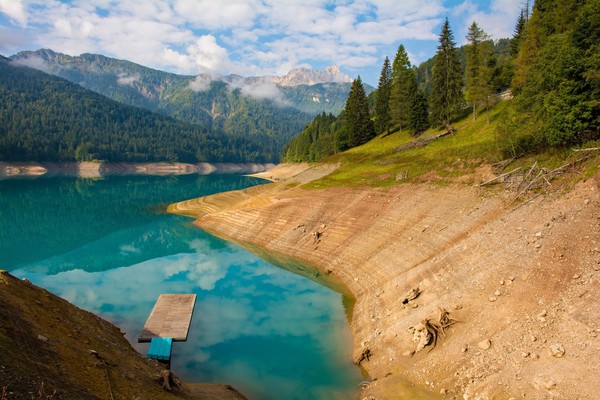
Innovative technologies to counter climate change
The development of innovative machines and cultivation techniques is the most effective weapon to combat the effects of global warming. From precision agriculture and biotechnology, a first response to drought and rising temperatures. The route is long but the road seems clear
The climate has changed. Without bothering Monsieur de La Palice, a few official numbers should be enough to convince the most stubborn supporters to the contrary. According to NOAA, the American National Climatic Data Center, 2023 was the hottest year ever on the planet with a temperature on the surface of the Earth and the seas that was more than one degree (1.18) higher than the average of the twentieth century and 0.15 degrees higher than the previous record of 2016. In Europe, the picture does not change: 2023 is second only to 2020 as the hottest year, with a temperature of 2.15 degrees higher than the historical average of 1910 - 2000. And if you look at Italy the score is the same. Perhaps declined for the worse. In Italy, 2023 was the hottest year ever recorded with an average temperature 1.14 degrees higher than the historical average for the period 1991-2020, according to Isac data, the CNR Institute of Atmospheric Sciences, which has been recording temperatures since 1800. A figure that is part of a worrying ranking: seven of the hottest years of the last two centuries are concentrated in the last decade. With a trend that doesn't seem to change. The first months of 2024 recorded a temperature of about one and a half degrees higher than the historical average. And, without exaggerating with regard to the famous French soldier who became a symbol of the obvious, even on the rainfall front, things have changed because, beyond a generalised drop in rainfall, it seems evident that the 'classic' 600 mm of rain that fell in a year are in no way comparable with the increasingly frequent 600 mm that fell in two days. The effects of these last phenomena in the short term (floods and damage) and in the medium-long term (the water goes away and is not stored) are significantly different. Definitely more negative.
Possible answers. In this scenario, the agricultural system cannot and must not remain inert. The possible answers are different and they move along some major lines. Which have the lowest common denominator in innovation and research. On the one hand, it is a matter of pushing for the adaptation and resistance of crops to environmental stress (water and thermal) and to the new phytopathological pitfalls favoured by climate change. On the other hand, to limit the effects of climate-altering practices, first of all the emission of greenhouse gases. On the other hand, to act on the technology front to make the best use of productive factors, including water. In the latter case, we are talking about precision agriculture, applied robotics, cutting-edge motoring, vertical farming just to mention booming sectors.
The road seems clear but the path is still long. Having said that the goal set in 2016 by the Guidelines of the Ministry of Agriculture (minister Maurizio Martina, now at FAO) to have 10% of the Italian agricultural area cultivated with precision agriculture techniques by 2021 has not yet been achieved, more than something has moved. The data from the Smart Agrifood Observatory of the Politecnico di Milano and the Rise Laboratory of the University of Brescia are very fresh (March 2024) and certify the exponential growth of digital agriculture technologies. In 2017, the 4.0 agriculture market in Italy was worth only 100 million, in 2022 it exceeded 2 billion euros (2.1 to be precise) and in 2023 it reached 2.5 billion, with an annual growth of close to 17%. Conversely, the area cultivated with 4.0 solutions remains low: from 6% in 2021 it rose to 8% in 2022 and is now valued at around 9%. Of course, the sector is in turmoil given that it involves more than 300 agritech companies and that, according to the same Observatory, precision agriculture measures and the digitalisation of work have already allowed a reduction in fuel consumption of at least 10% and processing times of more than 30%. Also according to the Observatory's estimates, precision farming techniques would have led to a drop in average production costs of around 15%; an increase in yields estimated between 7 and 15% for cereals and, finally, an increase in milk production in farms, estimated at 10-15%. Companies, from large to niche ones, are therefore working with fervor.
Low emission engines. Let's start with 'overinvestments' related to engines. It is true, as FederUnacoma points out, that the market for used machines has been booming for at least a decade, that the accumulation of obsolete machines is an obvious reality and that this affects efforts to reduce emissions of air pollutants. But it is equally true that many manufacturers have long been committed to the development of innovative vehicles powered by biomethane or zero emissions (e.g. electric). Which, the Federation itself recalls, should be more encouraged given their still reduced presence on the market. On the electrical front, there are several manufacturers already on track: Antonio Carraro, Argo Tractors with Landini, Bcs, Goldoni, Sdf with Vitibot just to name a few Italians, to which are added the world's big names New Holland, Agco with Fendt, Kubota and partly John Deere with the Sesam project, and the many Indian players (Farmtrac, Solis, Tafe). A list that is constantly updated, given that electricity is considered by most to be the real solution for the reduction of direct CO2 emissions . A reality that is already feasible in the small and medium power segments but which in high powers clashes with the capacity (indeed, this is the difficulty at the moment, given the weights and dimensions) of batteries to deliver powers comparable to those obtainable with classic diesel. Added to this are costs that are not yet fully competitive. However, electric remains the first option for the future and the one at a more advanced stage. Also because the idea of hydrogen seems to be getting farther away every day and methane (even in the bio version), which has already taken important steps on the machine front - for example with New Holland - has yet to adjust its pace in managing the network and supply. According to Ispra, the Italian Higher Institute for Environmental Protection and Research, the agricultural sector contributes about 9% to national Ghg (greenhouse gas) emissions, which in high concentrations cause the atmosphere to overheat and promote climate change. In addition to limiting direct emissions, it is therefore necessary to rationalise cultivation operations. With the precision and the help of new technologies, including robotic ones.
Robot friend. The market has literally exploded: in 2020 it was estimated to be worth between 4 and 5 billion dollars, in 2024 it should reach 10 billion dollars with a further doubling expected over the next two years. Agricultural robots and artificial intelligence are now considered valuable allies for the improvement of production processes and, consequently, for the reduction of their environmental impact. Once some regulatory problems, which are still in deficit, have been solved, they will become common use in a period of time estimated in a few decades. Instead, the realities of vertical agriculture, multi-level cultivation systems that allow production in an automated and controlled manner, regardless of climatic conditions, are already operational. The almost total recovery of the water resources used and the almost zero use of pesticides leads to savings of 95% of water and between 85 and 90% of soil, producing without interruption throughout the year. Of course, the initial investment is significant, but the cases of Planet Farms and the recent opening in the Verona area by Kilometro Zero of the largest plant in the “old continent” suggest that vertical farms are another appropriate response to the effects of climate change.
Precision for savings. Effects that find in precision agriculture the main answer. With micro-irrigation and fertigation being the immediate application examples already used in many agricultural enterprises. Technique and technology are now consolidated: knowing soil data and crop needs in advance, and combining these data with those relating to the seasonal trend, it is possible to precisely dose irrigation interventions, fertiliser inputs and now often also defence interventions. With obvious reductions in the consumption of technical vehicles, in the environmental impact and, nonetheless, in crop costs. The case histories are many. An example of this are fully automated fertilisation and irrigation systems, powered by solar energy systems, self-sufficient even in areas not reached by the electricity grid. But so are the platforms that integrate intelligent irrigation systems for the management of irrigation interventions with remote control systems for insect catches. Moreover, these platforms provide a forecast about the development of the insect populations themselves, thus directing the farmer towards optimal times and methods of intervention. But what can be the impact of these technologies? Obviously different depending on multiple variables (type of system, cultivation, intervention capacity). It is certainly relevant. A recent study by the University of Bologna carried out monitoring soil moisture through sensors in a yellow kiwi plant in Ravenna has made it possible to develop an effective irrigation strategy that led to 41% savings in water consumption between June and October 2023.
Another solution is sub-irrigation with Ultra Low Drip Irrigation systems (low flow distribution of dispensers), capable of distributing even just 0.6-0.7 l/h. This involves plant rainfall of between 0.4 and 0.8 mm/h and extended operating times, up to 10 hours a day. The slow release of water corresponds to the plant's instantaneous water consumption during the day: water losses due to deep percolation are practically eliminated, nutrient leaching is reduced and runoff phenomena are avoided. With this system, according to data collected as part of the Water4AgriFood project, in addition to greater irrigation efficiency, it is possible to obtain water savings of around 30%.
In terms of techniques for saving fertilisers aimed at reducing their environmental impact, FAO includes deep urea placement: by placing urea in smaller quantities, but deeper into the soil, it is possible to increase its effectiveness and contain its dispersion in the environment, also indirectly reducing the greenhouse gas emissions related to its production. Several tests on the use of foliar formulations inserted in precision agriculture strategies have shown a reduction in the carbon footprint of more than 90%.
The support of genetics. The closing is for genetics, which can significantly help combat the effects of climate change. After years of stand-by, the European Union has presented a new proposal for a regulation relating to plant improvement, opening up to Assisted Evolution Technologies (also known as TEA in Italy). The goal is to arrive at crops that are more suitable for resisting droughts and pathogens. It's going to take a while. Meanwhile, in many areas of the world, the first results have already arrived. For example, the Drought tolerant maize for Africa program, coordinated by the International Centre for Maize and Wheat Improvement (Cyynt) and the International Institute for Tropical Agriculture (CIAT), has made it possible to develop and distribute more than one hundred varieties of maize that are particularly resistant to drought. Varieties that could prove essential to preserve food security in the sub-Saharan region. Closer to us, we can mention the virtuous case of resistant vines (Piwi); varieties developed over the last decade capable of counteracting the attacks of fungal diseases, downy mildew and powdery mildew in the first place. In essence, if the climate changes, the tools and options available to the farmer must also change. The prodromes are all there.








